Accessories for the toilet - we care about plumbing
The basic requirements of the consumer to the work of the drain tank are in its silent filling, no leakage and good flushing. But the very first failure can become a real psychological and sanitary catastrophe, turning the usual way of life on its head. The tank fittings adjusted to the millimeter will bring harmony into family life, will not spoil relations with neighbors and, moreover, will allow saving water.

The wettest place in the toilet
Old models of tanks were located high above the toilet, connecting with a long pipe. Accessories for the toilet cistern was devoid of any design innovations, but it worked well and the drainage process took place like in a fairy tale - pull the string, water and flow. The valve, which closes the drain hole and descends back after the tank has been emptied, worked clearly according to the formula P = mg.
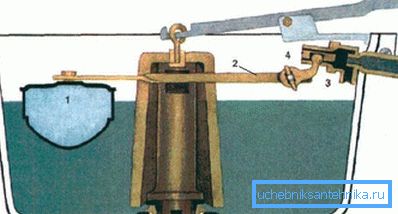
The product had, above all, a utilitarian purpose, disregarding the aesthetic perception of reality. The undeniable advantage of the device was the strong pressure of the jet. Saving room space still attracts fans of the Soviet design, which in its modern version can look quite attractive and cause nostalgia.

Significant differences of modern built-in and compact models from rarities are:
- in the vertical arrangement of the float, before it was located horizontally;
- the volume is filled with water faster;
- the inlet is closed by the shut-off valve completely after filling the tank;
- this valve is located not in the side wall of the tank, but at the bottom;
- draining by pressing a button;
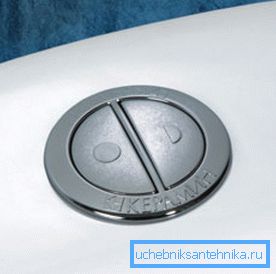
- the amount of water flushed into the toilet can be dosed, which leads to significant savings.
Domestic sanitary fittings have a hygienic certificate and are performed in accordance with the requirements of GOST 21485-94, in which there is one omission. Certain inconvenience causes the need to apply a force of up to 3 kg when pressing the drain button. It is difficult for elderly people with sore joints, small children and vintage ladies with a long manicure.
Variety of cisterns
Accessories for the toilet cistern and the cistern itself can be classified according to several parameters:
- product material - faience, as a rule, for compact models, plastic, embedded, and cast-iron amateur;
- location - high on the wall, directly above the toilet, on the shelf closet and installation in the wall;
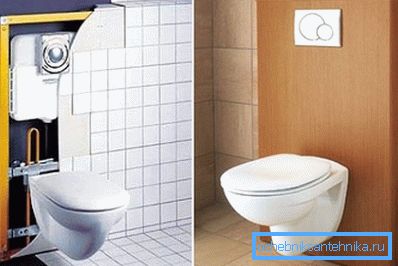
- the type of drainage mechanism - the lateral location of the button / drain lever is typical for tanks at a height, the upper one, which is inherent in a compact product, and a button on the wall near hidden tanks;
- model - exhaust (raising the stem opens the drain hole) and a push-button, made in three versions: press-full / partial drain and a button interrupting the procedure when you see fit;
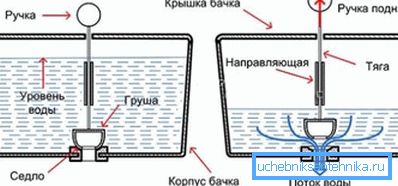
- filling of the tank - supply of water to the side (the operation is quite noisy) and from the bottom - a silent process in which water enters the fountain;
- Reinforcement material is metal and plastic, which is durable in hard tap water.
Note! If the manufacturer did not manage to do this, you yourself can successfully “calm down” the pouring process - insert a piece of soft rubber / silicone tube from the inside into the inlet opening, lowering it closer to the bottom, and you will no longer hear annoying bubbling.

The principle of operation of any toilet tank is the same:
- water is poured into the tank, passing through the plumbing fixture - a flexible hose connecting the water supply to the tank;
- “Starting” the mechanism by pressing the button / lever, the valve at the junction of the tank and the toilet opens and releases water that washes the inner surface of the toilet;
- the capacity is replenished by the work of the float, which goes down with the spoke.
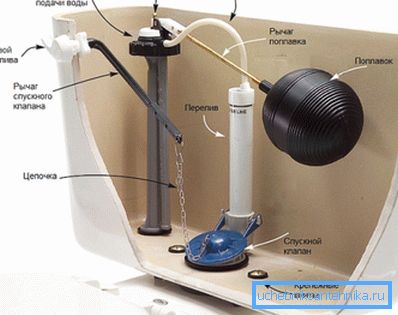
The level of incoming water is regulated by a float, or rather, a screw inside it. If the water level is approaching a critical level, the float is lowered, the volume is not completely filled - it is raised.
When the hidden becomes clear
Accessories for a toilet cistern can become a cornerstone for a person inexperienced in plumbing subtleties.
In fact, it consists of only three whales:
- plumbing;
- shut-off valve;
- drain fittings.
The work of these systems is interconnected and, considering the peculiarities of the work of one, the other two will certainly be in sight. The common denominator for all three elements will be water, which sets them in motion, and itself will be driven by their work.
What hides the valves
The shutoff valve includes the entire internal filling of the drain tank, the functions of which include filling an empty container and blocking the water supply to the filled one.
The main element of the mechanism is a check valve:
- "Croydon" with a vertical movement of the piston, was widely used in old-mode tanks;
- membrane rubber / silicone, the Achilles heel of which is the destructive action of water, limiting the working life of parts from 3 to 5 years, followed by the inevitable replacement of the entire site. When choosing a replacement, it is important to know the exact diameter of the supply pipe — a standard internal diameter of 10–15 mm;
- piston, which moves horizontally. The water level is regulated by a gasket at the end of the piston and the pouring stops under the pressure of the piston on the saddle.

Note! Water quality can be improved by placing a filter in front of the filler hole, and using a pill inside the tank to soften it.
Also valves can be separate and combined. In the first version, the drain and filler valves function autonomously and have separate valves for each respective hole. The obvious convenience of such a system lies in the simple dismantling and inexpensive repair of a specifically damaged node.
The latest samples of elite class drain devices are equipped with a single drain and fill valve system with traction dependence. The price of such a system is high and requires increased accuracy, so its installation is better to entrust a specialist.
Ideally adjusted mechanism will provide its perfect work. The disadvantage of this option can be considered weak suitability for repair, in case of breakage of the thrust, most likely, you will have to change the entire unit.
Drain and collect water according to the law
Drain and water intake fittings:
- for opening the drain hole with the push of a button / lever;
- closing the same hole to fill the tank with water;
- emergency discharge in case of breakage of stop valves.
The main elements of the valve:
- ball valve with a lever that opens the water in the tank;
- a float connected by a lever system with a drain mechanism and regulating the level of incoming water;
- siphon directly responsible for the drain.
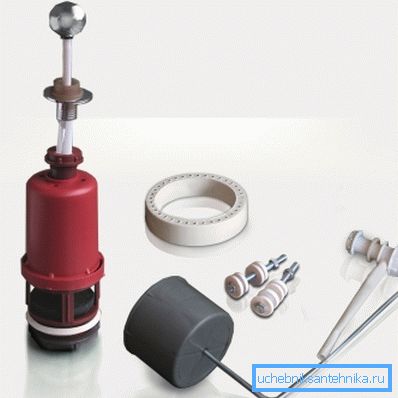
Repair rules
Failures of sanitary fittings have different reasons:
- Manufacturing defect. You can insure against such a trouble by refusing to buy cheap devices from an unknown manufacturer.
- The discrepancy between imported parts and domestic conditions. For example, the membrane of the European sample will be defenseless against the action of hard water from the local spill.
- Self-caused problems - most often occur with excessive pressure on the drain button.
- Deformation of plastic elements from hot water, which local Kulibins are poured into the tank, trying to get rid of condensate on the inner walls.
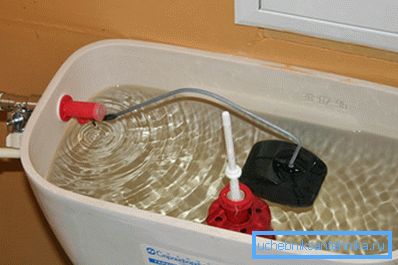
Some parts that fail, are forced to change in the end the entire site due to the peculiarities of design connections. For example, the need to replace the float valve when one float breaks will increase your costs from about 4 rubles to 300. Because the float is a whole with the lever and the arm length is different for each model.
Certain difficulties arise in the repair of equipment from an elite manufacturer, which has its own branded "chips", which, with all the desire, can not be replaced by cheaper samples. For example, the Ido and Ifo toilets have an original shape opening for the drain button and also their own circle of raw material suppliers, which affects the quality of the fittings, distinguishing it from others.
Note! When buying parts it is better to record the parameters of the tank, the height of the toilet bowl, the location of the liner, etc. It is even better to bring the broken unit / part with you.

Typical damage
Once in the life of each user, a moment comes when he is forced to learn the principle of the work of the drain product in order to save time and money on the call of the master.
Malfunctions in plumbing fixtures are often similar, and the “symptomatology” instructions will help orient you on the spot:
- non-stop pouring water into the tank capacity - the bias of the float leverbut. If, after regulation, the problem persists, it is likely that water enters the float and it sinks, losing its purpose. Outlet - the acquisition of a new float valve;
- continuous flow in the toilet bowl - undisputed damage to the membrane that needs to be replaced;
- "Wrong" portions of drained water - possible contamination of the holes for the passage of water. With a float, remove the cap with a turning movement, remove the membrane (it is better to change it to a new one) and rinse the ducts;
- the tank is flowing at the junction with the toilet - the rubber ring at the junction has worn out and is simply replaced with a new one of exactly the same diameter.

In conclusion
There are situations in life when buying cheap things is unprofitable, and sanitary fittings are worthy of a certain "waste". Her work does not stop for a minute and the margin of safety that only reputable manufacturers can provide pays off with whole nerve cells.
In the video in this article, a specialist clearly explains the principle of operation of the tank fittings and shows ways to eliminate the main faults.